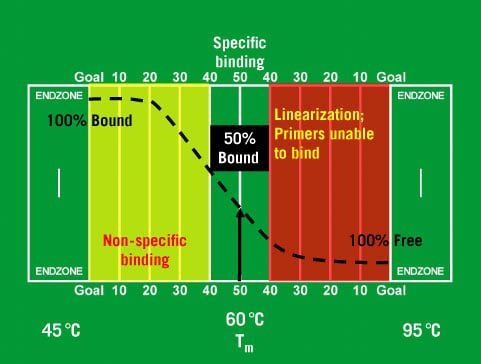Originally published : Tue, January 26, 2010 @ 5:00 PM
Updated : Mon, September 19, 2022 @ 2:10 PM
A "Referral from the Doctor" Blog Article-
The aim of the Polymerase Chain Reaction (PCR) method is to amplify or increase the number of copies of a target sequence. Most often that sequence is part of a gene of interest and the total copy number or relative copy number of that transcript will impart some knowledge to the researcher regarding the impact of a drug, disease status of a sample or may represent a control condition. In some situations, the copy numbers of a particular transcript are very low and it may be necessary to nudge the PCR reaction in favor of amplifying the exact splice variant, family member or a construct the researcher wishes to examine.

In PCR, the temperature at which primers anneal during a cycle determines the specificity of annealing. The melting point (Tm) of the coolest primer sets the upper limit on annealing temperature. At temperatures just below the Tm, only very specific base pairing between the primer and the template will occur. As the temperature decreases, primer binding becomes less specific. Non-specific primer binding results in the amplification of undesired products and may mask the actual copy number of the gene of interest.
Touchdown PCR (Step-down PCR) is a variant of qPCR that reduces nonspecific target amplifications by gradually lowering the annealing temperature as PCR cycling progresses. The annealing temperature at the initial cycles is usually a few degrees (3-5 °C) above the Tm of the primers used. This ensures high specificity binding of the primers and is least-permissive of non-specific binding. As the PCR continues, each cycle occurs at lower and lower temperatures, decreasing by 0.2 °C per cycle. At the later cycles, it is a few degrees (3-5 °C) below the primer Tm. The higher temperatures give greater specificity for primer binding, and the lower temperatures permit more efficient amplification from the specific products formed during the initial cycles. Thus, the first sequence amplified is the one between the regions of greatest primer specificity and will be the most abundant product after cycling is complete.
This method is effective for amplification of one or only a few gene transcripts at a time. For larger comparative studies, standard PCR thermocycling conditions are recommended.Written by: Christina Ferrell, Ph.D., Technical Applications Specialist
Hecker K, Roux K (1996). "High and low annealing temperatures increase both specificity and yield in touchdown and stepdown PCR". Biotechniques 20 (3): 478-85. PMID 8679209

